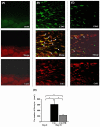Activation of p38 mitogen-activated protein kinase promotes peritoneal fibrosis by regulating fibrocytes
- PMID: 21719683
- PMCID: PMC3525367
- DOI: 10.3747/pdi.2010.00200
Activation of p38 mitogen-activated protein kinase promotes peritoneal fibrosis by regulating fibrocytes
Abstract
Background: Peritoneal fibrosis is a serious complication of long-term peritoneal dialysis, and yet the precise pathogenic mechanisms of peritoneal fibrosis remain unknown. Fibrocytes participate in tissue fibrosis and express chemokine receptors that are necessary for migration. The p38 mitogen-activated protein kinase (MAPK) pathway regulates the production of chemokines and has been demonstrated to contribute to the pathogenesis of various fibrotic conditions. Accordingly, we used an experimental mouse model of peritoneal fibrosis to examine the dependency of fibrocytes on p38MAPK signaling.
Methods: Peritoneal fibrosis was induced in mice by the injection of 0.1% chlorhexidine gluconate (CG) into the abdominal cavity. Mice were treated with FR167653, a specific inhibitor of p38MAPK, and immunohistochemical studies were performed to detect fibrocytes and cells positive for phosphorylated p38MAPK. The involvement of p38MAPK in the activation of fibrocytes also was also investigated in vitro.
Results: Fibrocytes infiltrated peritoneum in response to CG, and that response was accompanied by progressive peritoneal fibrosis. The phosphorylation of p38MAPK, as defined by CD45+ spindle-shaped cells, was detected both in peritoneal mesothelial cells and in fibrocytes. The level of peritoneal expression of CCL2, a chemoattractant for fibrocytes, was upregulated by CG injection, and treatment with FR167653 reduced the number of cells positive for phosphorylated p38MAPK, the peritoneal expression of CCL2, and the extent of peritoneal fibrosis. Pretreatment with FR167653 inhibited the expression of procollagen type I α1 induced by transforming growth factor-β1.
Conclusions: Our results suggest that p38MAPK signaling contributes to peritoneal fibrosis by regulating fibrocyte function.
Figures







Comment in
-
A role for fibrocytes in peritoneal fibrosis?Perit Dial Int. 2012 Jan-Feb;32(1):4-6. doi: 10.3747/pdi.2011.00071. Perit Dial Int. 2012. PMID: 22302922 Free PMC article. No abstract available.
Similar articles
-
Deletion of p38 MAPK in macrophages ameliorates peritoneal fibrosis and inflammation in peritoneal dialysis.Sci Rep. 2024 Sep 11;14(1):21220. doi: 10.1038/s41598-024-71859-5. Sci Rep. 2024. PMID: 39261560 Free PMC article.
-
A role for fibrocytes in peritoneal fibrosis?Perit Dial Int. 2012 Jan-Feb;32(1):4-6. doi: 10.3747/pdi.2011.00071. Perit Dial Int. 2012. PMID: 22302922 Free PMC article. No abstract available.
-
MicroRNA-21 contributes to high glucose-induced fibrosis in peritoneal mesothelial cells in rat models by activation of the Ras-MAPK signaling pathway via Sprouty-1.J Cell Physiol. 2019 May;234(5):5915-5925. doi: 10.1002/jcp.26941. Epub 2018 Dec 4. J Cell Physiol. 2019. Retraction in: J Cell Physiol. 2022 Mar;237(3):2001. doi: 10.1002/jcp.30513. PMID: 30515805 Retracted.
-
Preventing peritoneal membrane fibrosis in peritoneal dialysis patients.Kidney Int. 2016 Sep;90(3):515-24. doi: 10.1016/j.kint.2016.03.040. Epub 2016 Jun 7. Kidney Int. 2016. PMID: 27282936 Review.
-
Mechanisms underlying the involvement of peritoneal macrophages in the pathogenesis and novel therapeutic strategies for dialysis-induced peritoneal fibrosis.Front Immunol. 2024 Dec 19;15:1507265. doi: 10.3389/fimmu.2024.1507265. eCollection 2024. Front Immunol. 2024. PMID: 39749340 Free PMC article. Review.
Cited by
-
High-Density Lipoprotein (HDL) Inhibits Serum Amyloid A (SAA)-Induced Vascular and Renal Dysfunctions in Apolipoprotein E-Deficient Mice.Int J Mol Sci. 2020 Feb 15;21(4):1316. doi: 10.3390/ijms21041316. Int J Mol Sci. 2020. PMID: 32075280 Free PMC article.
-
The Role of Tyrosine Kinase Receptors in Peritoneal Fibrosis.Perit Dial Int. 2015 Sep-Oct;35(5):497-505. doi: 10.3747/pdi.2014.00171. Perit Dial Int. 2015. PMID: 26450477 Free PMC article. Review.
-
Encapsulating Peritoneal Sclerosis - A rare and serious complication of peritoneal dialysis: Case series.J Med Life. 2014;7 Spec No. 3(Spec Iss 3):8-12. J Med Life. 2014. PMID: 25870687 Free PMC article.
-
Dialysate cytokine levels do not predict encapsulating peritoneal sclerosis.Perit Dial Int. 2014 Sep-Oct;34(6):594-604. doi: 10.3747/PDI.2012.00305. Epub 2014 Mar 1. Perit Dial Int. 2014. PMID: 24584593 Free PMC article.
-
Deletion of p38 MAPK in macrophages ameliorates peritoneal fibrosis and inflammation in peritoneal dialysis.Sci Rep. 2024 Sep 11;14(1):21220. doi: 10.1038/s41598-024-71859-5. Sci Rep. 2024. PMID: 39261560 Free PMC article.
References
-
- Selgas R, Fernandez–Reyes MJ, Bosque E, Bajo MA, Borrego F, Jimenez C, et al. Functional longevity of the human peritoneum: how long is continuous peritoneal dialysis possible? Results of a prospective medium long-term study. Am J Kidney Dis 1994; 23:64–73 - PubMed
-
- Davies SJ, Bryan J, Phillips L, Russell GI. Longitudinal changes in peritoneal kinetics: the effects of peritoneal dialysis and peritonitis. Nephrol Dial Transplant 1996; 11:498–506 - PubMed
-
- Cnossen TT, Konings CJ, Kooman JP, Lindholm B. Peritoneal sclerosis—aetiology, diagnosis, treatment and prevention. Nephrol Dial Transplant 2006; 21(Suppl 2):ii38–41 - PubMed
Publication types
MeSH terms
Substances
LinkOut - more resources
Full Text Sources
Other Literature Sources
Research Materials
Miscellaneous

